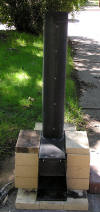An Experiment with a Rocket Stove - page 2
I made a larger, improved version of the previous rocket stove. One 8" x 24"
black vent pipe is used to make the chimney, a bottom for the heating chamber,
and the separator plate. The heating chamber is formed from another one. An 8" x
24" vent pipe was used to make an insulating barrier around the chimney to hold
in heat. All the vent pipe used was 24 gauge. The space between the two pipes
could be filled with vermiculite, burned wood, or some other low density, heat
resistant material for better heat retention. A circular piece of aluminum
flashing was used at the chimney top to cover the air space between the chimney
and insulator pipe. A hinged flap was added to lower the amount of air coming in
on top of the wood. Steel "pop-rivets" (1/8" diameter, 1/4" grip range) were
used instead of screws (Aluminum ones would melt). Bricks were piled around the
heating unit to keep it from falling over. I picked up the materials at a local
Menards store, but any large hardware store should have the parts. Total cost
was about $20. This is only the core of the stove. A suitable support structure
around the heating section and a properly-sized skirt would need to be added to
make a stove. As with the previous stove designs, this stove would need to be
used with adequate ventilation and other safety precautions. The interior gets
hot enough to melt aluminum.
The wood inlet chamber is 6" high and the air inlet is 2 1/2" high (8 1/2"
total). The hinged flap is 3" high. The separator plate is remove-able for
cleanout. The entrance is 4 3/4" wide at the top and 5 1/2" wide at the bottom.
The length of the chamber is 13". The chimney is 18" high and 4 1/2" diameter.
The picture on the right shows an 8" diameter insulating shield added over the
chimney to help hold in heat. A cover made from aluminum flashing material
covers the top to close the air gap between the two.



A test to heat one-half gallon of water to boiling
Used the bucket skirt from the previous design to hold 7 1/2 quart cook pot.
Concrete 8" half-blocks and paver blocks used as support. Chimney
insulating cover not used for test. Air Temp.
47F. No breeze. About 5 min. warm-up to stabilize burning.
10:16 am Start of test
10:25 am Water at a "rolling" boil
Nine minutes to bring one-half gallon of water to a boil. A better skirt design
would have improved the heat transfer to the pot. The heating time wasn't much
better than the previous design (20 min. to heat 4 liters), but I was also only
using it at 1/3 to 1/2 of its capacity. The metal heat chamber should last
longer that way.

Below is a size comparison between the heating cores of this version and the
previous one. Note the hinged flap at the top of the wood inlet of this heating
core to lower the amount of air flowing in on top of the wood. This helps keep
the wood from burning too close to the entrance when smaller amounts of wood are
burned and improves the "draw" on the air inlet below. The slide-in fuel/air separator plate is not shown on the smaller model.

From my testing I came up with a general guide for minimizing smoke
here.
NEXT PAGE
PREVIOUS PAGE
HOME PAGE




